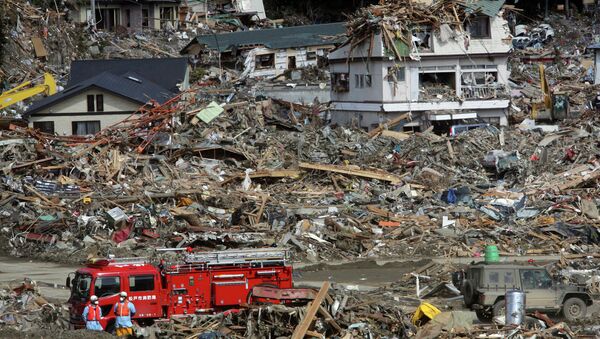The minute's silence has been announced via loudspeakers installed on the streets across the country and on cars of the local administrations. Following the minute's silence a ceremony commemorating the victims was launched with participation of Japanese Emperor's family and members of government and parliament.
READ MORE: 'Walls Are Shaking': Strong Earthquake Rocks Japan (PHOTO)
Seven years ago, on March 11, 2011, a 9.0-magntude earthquake hit north-eastern parts of Japan killing about 16,000 people in 12 Japanese prefectures. The majority of victims (93 percent) died from the tsunami triggered but the quake. A total of 2,539 people are still missing and 30,000 are living in temporary housing.
I never forget 11 th March 2011,
— 赤城春輔HarusukeAkagi (@kamewoaisuru) 11 марта 2018 г.
people in Japan who had the big earthquake and tsunami,
people from a lot of country who helped us.
H. Akagi#thankyou #thankyouverymuch #earthquake #tsunami #naturaldisaster#japan #地震 #津波 #東日本大震災 #天災 #防災 #オリジナル #日本 pic.twitter.com/Zk8EZqCU6i
#OnThisDay in 2011, an earthquake measuring 9.0 shook NE Japan, triggering savage tsunami and catastrophic Fukushima nuclear disaster. Seven years on, people are still in the process of recovery pic.twitter.com/j0MJeJbfFa
— CGTN (@CGTNOfficial) 11 марта 2018 г.
This Sunday marks the 7th anniversary of the 2011 Tohuku Japan #Earthquake & #Tsunami. The event was a turning point for earthquake and tsunami science as it challenged the scientific community’s understanding on how large an earthquake could be on the Ring of Fire. pic.twitter.com/U41pdrPoWG
— Geoscience Australia (@GeoscienceAus) 9 марта 2018 г.
The 46-foot tsunami also hit Japan's Fukushima nuclear power plant, leading to the leakage of radioactive material into the surrounding environment and the shutdown of the plant. The accident is considered to be the world's worst nuclear disaster since the Chernobyl accident of 1986 in Soviet Union.


